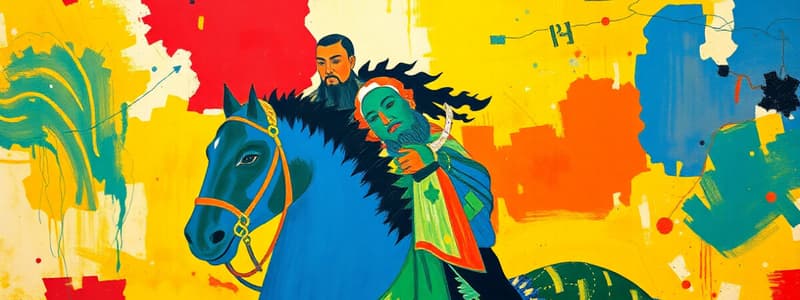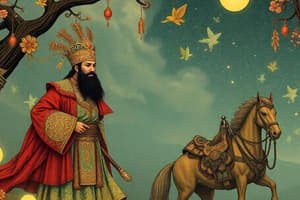Podcast
Questions and Answers
What was Genghis Khan known for besides being a great warrior?
What was Genghis Khan known for besides being a great warrior?
- Developing a new religion
- Establishing the Ming dynasty
- Unifying Mongol clans (correct)
- Creating the Sui Dynasty
Which dynasty did Kublai Khan establish in China?
Which dynasty did Kublai Khan establish in China?
- Tang Dynasty
- Sui Dynasty
- Ming Dynasty
- Yuan Dynasty (correct)
What was a major consequence of Mongol rule in China?
What was a major consequence of Mongol rule in China?
- Promotion of civil service tests for all citizens
- Decline in agricultural productivity
- Complete cultural assimilation with Chinese
- Encouragement of trade and contact with Europe (correct)
What was the purpose of the Grand Canal built during the Sui Dynasty?
What was the purpose of the Grand Canal built during the Sui Dynasty?
Who was the only female ruler to govern China independently?
Who was the only female ruler to govern China independently?
What was Neo-Confucianism a blend of?
What was Neo-Confucianism a blend of?
What was a result of the civil service examination system in China?
What was a result of the civil service examination system in China?
What one key characteristic defined the Song dynasty's government?
What one key characteristic defined the Song dynasty's government?
What did Marco Polo notably do during his time in China?
What did Marco Polo notably do during his time in China?
What was one of the main outcomes of the Ming dynasty's policies?
What was one of the main outcomes of the Ming dynasty's policies?
Flashcards
Clan
Clan
A group of people, often related, who live and work together. They are a fundamental unit in nomadic societies, like the Mongols.
Genghis Khan
Genghis Khan
A powerful Mongolian ruler who united the Mongol tribes and conquered vast territories, ultimately establishing the Mongol Empire.
Genghis Khan's New Legal Code
Genghis Khan's New Legal Code
A legal system established by Genghis Khan to govern the vast Mongol Empire. It provided a framework for law and order across conquered territories.
Yuan Dynasty
Yuan Dynasty
Signup and view all the flashcards
Kublai Khan
Kublai Khan
Signup and view all the flashcards
Marco Polo
Marco Polo
Signup and view all the flashcards
Civil Service Exam
Civil Service Exam
Signup and view all the flashcards
Sui Dynasty
Sui Dynasty
Signup and view all the flashcards
Tang Dynasty
Tang Dynasty
Signup and view all the flashcards
Song Dynasty
Song Dynasty
Signup and view all the flashcards
Study Notes
Mongol Empire
- Mongols lived in yurts and raised horses, sheep, and yaks.
- Organized into clans and followed herds.
- Skilled horseback riders and warriors using swords, arrows, and spears.
- Genghis Khan unified Mongol clans and created a legal code.
- 100,000 trained warriors with skilled officers leading them.
- Collected tribute and recruited new soldiers.
- Known for aggressive warfare, looting, and burning cities.
- Divided into four territories, controlling land from the Pacific Ocean to Eastern Europe and the Himalayas.
- Promoted trade between Asia and Europe and taxed products for revenue.
Mongol Conquest of China
- Kublai Khan continued the conquest and declared himself emperor.
- Established the Yuan Dynasty, appointing Mongol leaders to Chinese government positions.
- Maintained distinct Mongol culture, language, and customs, separate from Chinese culture.
- Respected conquered cultures.
Mongol Rule in China
- Controlled all of China.
- Ensured Yuan officials obeyed Mongol rulers.
- Attracted foreign visitors, increasing trade along the Silk Road, and fostered peace and stability.
- The Mongols didn't use the civil service exam. They were open to non-Chinese.
Marco Polo
- Venetian traveler who lived in China for 16 years.
- Wrote about his experiences and observations, including the well-planned city streets.
- Provided information about other regions.
- Served in government positions and returned to Italy.
Mongol Empire and Trade
- Expanded into Korea but failed to conquer Japan.
- Controlled vast territory connecting China to Europe.
China Rebuilds its Empire (Sui Dynasty)
- The Sui Dynasty unified China under emperor Wendi and Yangdi.
- Repaired the Great Wall.
- Rebuilt Chang'an (modern-day Xi'an).
- Built the Grand Canal connecting the Huang He and Chang Jiang rivers (North and South China).
- Used forced labor from farmers to build infrastructure, leading to revolts.
Tang Dynasty
- Lasted 300 years and established a strong central government.
- Taizong, a powerful ruler, brought back the civil service exam.
- Selected officials based on exam performance.
- Granted land to farmers.
- Promoted trade and wealth, urban development.
- Empress Wu, the only female emperor, strengthened the government.
- Lost control of the Silk Road.
- Weakened by rebellions and military governors.
Song Dynasty
- Strongest and most centralized government.
- Featured commercial and technological advancements resulting in prosperity and cultural flourishing.
- Famous for landscape painting.
- Nomadic tribes captured the north and the capital moved south.
Buddhism in China
- Introduced by traders and missionaries.
- Offered peace, comfort, and escape from suffering, appealing to people during troubled times.
- Buddhist monks and nuns supported communities.
- Buddhism spread to Korea.
- Some opposed it, fearing its wealth and impact on family structures.
Revival of Confucian Ideas
- Neo-Confucianism blended Buddhist and Daoist beliefs, emphasizing social responsibility and concern for the afterlife.
- It became a prominent religious tradition.
- Adapted Confucian ideas to appeal to a broader population, becoming less elitist.
Civil Service System
- Strengthened Chinese government by ensuring officials were less likely to be corrupt.
- Only men could take the exam.
- Favored the wealthy, as poor students couldn't afford tutors.
- High failure rates.
- Those who did not pass received alternative government jobs or teaching positions.
- Created a new scholar-official class, largely excluding those with manual trades.
Ming Dynasty
- Established peace and order under a harsh leader who trusted few.
- Punished suspected traitors harshly but brought about stability.
- Capital moved to Beijing.
- Reinstated the civil service exam.
- Conducted censuses and improved tax collection.
- Rebuilt canals and roads.
- Agriculture thrived.
- Economy expanded.
Ming Arts and Literature
- Produced novels written in vernacular language.
Ming Exploration
- Built large fleets to sail to other countries demonstrating power and exploring beyond China's coast.
Zheng He's Voyages
- Traded Chinese goods, such as silk, paper, and porcelain.
- Brought back exotic animals like giraffes.
- Faced criticism that expeditions were expensive and introduced unnecessary foreign ideas.
Arrival of Europeans in China
- Portuguese ships arrived, initially facing Chinese resistance to trade.
- China gradually accepted more trade, but resisted Christianity.
Fall of the Ming Dynasty
- Dishonest officials took over.
- Heavy taxes on farmers led to revolts.
Studying That Suits You
Use AI to generate personalized quizzes and flashcards to suit your learning preferences.




